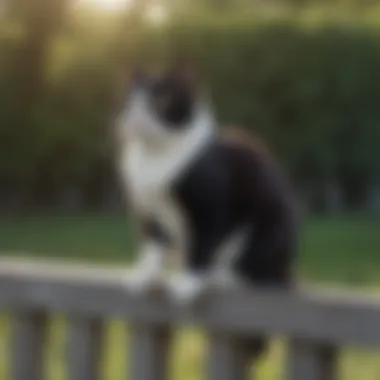Exploring the Found Tuxedo Cat: Care and Integration Guide


Intro
Tuxedo cats capture attention with their unique black and white coloring. They are not a specific breed but rather a color pattern found in various breeds. Their playful and social nature makes them attractive companions. Understanding the characteristics and needs of these cats is crucial for anyone considering adopting or caring for one. This section discusses the aspects of tuxedo cats that potential guardians need to know.
Animal Species Profile
Prelims to the animal species
Tuxedo cats are known for their distinctive appearance, resembling a formal attire. This pattern can occur in any breed or mix of breeds. Common breeds with tuxedo markings include the Domestic Shorthair, Maine Coon, and American Shorthair. Their personalities often match their dapper looks, making them a favorite among families and individuals alike.
Physical characteristics and appearance
Tuxedo cats typically have a black coat with white markings. These markings can vary widely, often including white paws, a white chest, and a white mustache-like marking on the face. Their size can range from small to large, depending on their breed. Generally, they are sturdy cats with strong build, allowing them to be playful and active.
Natural habitat and distribution
Found primarily in urban environments, tuxedo cats often adapt well to indoor living. However, they can also thrive outdoors if they have proper shelter and care. Their resilient nature allows them to find food and resources easily, but not all tuxedo cats share the same luck. Those living as strays often face various challenges, which leads to a need for community efforts to assist them.
Behavior and social interactions
Tuxedo cats tend to be sociable, often forming strong bonds with their human companions. They exhibit affectionate behavior and often engage in playful activities. Their intelligence is notable, as they can learn tricks and adapt to various environments. Like many cats, they communicate through body language and vocalizations, conveying their needs and desires to their caretakers.
Pet Care & Tips
Choosing the right pet for your lifestyle
When considering a tuxedo cat, assess your environment and daily routine. These cats enjoy human interaction but can also appreciate solitary moments. Ensure you have the time and resources to properly care for them.
Basic care requirements and habitat setup
A tuxedo cat requires a balanced diet, regular veterinary check-ups, and a safe environment. Provide a litter box, scratching posts, and toys to prevent boredom. Understand their grooming needs based on their fur type.
Health and wellness tips for pet longevity
Regular veterinary check-ups are essential to monitor for any health issues. Vaccinations, parasite control, and dental hygiene are critical components of maintaining their health. A proper diet tailored to their age and activity level will support their overall wellbeing.
Training techniques and behavioral enrichment ideas
Training can be a rewarding experience for both cat and owner. Use positive reinforcement to teach commands or tricks. Engaging toys can help keep a tuxedo cat active and mentally stimulated, which is key to their happiness.
By understanding the various aspects of tuxedo cats, you become better equipped to offer them a loving and responsible home. Their charm and character can enrich your life in many ways, making it worthwhile to invest time and care into this unique animal.
Prologue to Tuxedo Cats
Understanding Tuxedo Cats is essential for anyone who finds themselves in contact with these distinct felines. This section aims to illuminate the unique characteristics and needs of tuxedo cats. Unlike other breeds, these cats possess not only a striking appearance but also are often beloved for their personalities. Their black and white coat captivates many, making them one of the most recognizable cat types. Knowing their traits and behavior enables prospective adopters to make informed decisions regarding care and companionship.
Understanding Tuxedo Cats
Tuxedo cats are commonly recognized by their distinctive color pattern. They feature a predominantly black coat with notable white markings resembling a tuxedo. This unique appearance stems from a genetic pattern rather than a specific breed. A mix of various breeds can result in a tuxedo cat, allowing for a range of personalities and sizes.
In general, tuxedo cats often display sociable and affectionate behaviors. They can be curious and playful, making them excellent companions for families and individuals alike. However, it is crucial to realize that every cat has its individual personality. Fostering a genuine understanding of these traits can help in establishing a strong bond, making each cat's adaptation into a new home smoother.
Common Misconceptions
Despite their charm and popularity, many misconceptions surround tuxedo cats. Here are a few.


- Identifying a Breed: A common misunderstanding is that tuxedo cats are a specific breed. They are, in fact, a color pattern found across various breeds.
- Temperament Assumptions: Many believe that all tuxedo cats have the same personality due to their appearance. In truth, like all cats, they possess varying temperaments influenced by genetics and environment.
- Myth of Good Luck: Some cultures regard tuxedo cats as omens of good fortune. While they can bring joy, their luck is not guaranteed.
Recognizing and addressing these misconceptions is vital for potential pet owners. A deeper understanding will support responsible adoption and prevent unrealistic expectations.
Recognizing a Found Tuxedo Cat
Recognizing a found tuxedo cat is essential for anyone who encounters this unique feline. Tuxedo cats are easily distinguishable by their black and white markings, resembling a formal tuxedo outfit. Understanding their physical characteristics and behavioral indicators can aid in identifying these cats and addressing their needs. This knowledge is important for ensuring the cat's safe transition into a new environment, whether that be a new home or a shelter.
Physical Characteristics
The physical appearance of a tuxedo cat is one of its most notable features. These cats typically have a pattern of black fur with white patches, usually covering their paws, chest, and face. Here are some key characteristics:
- Coat Pattern: The combination of black and white fur creates a striking contrast. The specific pattern can vary from cat to cat, with some having symmetric designs and others being more random.
- Size and Build: Tuxedo cats exhibit a variety of sizes, from small to large breeds. Generally, they have a sturdy body structure, making them appear robust.
- Eye Color: Their eye color can range from green to yellow, often adding to their visual appeal.
Identifying these features quickly assists in recognizing a tuxedo cat, especially if one is found wandering in your neighborhood.
Behavioral Indicators
Understanding the behavioral traits of tuxedo cats is equally important. These cats tend to exhibit certain behaviors that can provide insight into their temperament and state of mind. Here are some common behavioral indicators:
- Social Interaction: Tuxedo cats are known for being sociable. They often enjoy interacting with humans and other pets. If a found cat approaches you, it may be particularly friendly and curious.
- Vocalization: Many tuxedo cats are vocal. They may meow, purr, or chirp to communicate. If a cat is found making frequent sounds, it might be seeking attention or expressing its state of discomfort.
- Playfulness: These cats tend to have playful personalities. Look for signs of playfulness, such as chasing invisible prey or interacting with objects around them. This can indicate a healthy cat that is simply lost or separated from its home.
Recognizing both physical traits and behavior is vital when encountering a found tuxedo cat. By doing so, you can better assess the cat's needs and begin to take appropriate action.
Immediate Steps Upon Finding a Tuxedo Cat
Finding a tuxedo cat can be both a joyful and challenging experience. When you encounter a stray or lost tuxedo cat, the first thing to do is to remain calm and take suitable steps. The importance of this process cannot be overstated. By adopting immediate and responsible actions, you not only increase the chances of safely reuniting the cat with its owner, but you also contribute to the overall welfare of the feline community. Below are key steps that should be taken as soon as you find a tuxedo cat.
Assessing the Situation
The first action is to assess the situation carefully. Look at the condition of the tuxedo cat. Is it healthy? Is it scared or aggressive? Taking note of its behavior can provide useful insight into how to proceed. If the cat appears to be stray, it may be frightened or confused. Moving slowly and speaking softly can help the cat feel more at ease.
Consider the environment. Is the cat in a busy street or a quiet yard? A calm area allows you to approach without causing unnecessary stress. Try to avoid sudden movements. It’s wise to check if the cat has any identifiable features such as a collar or microchip. If it has an owner, returning it quickly and safely is the best outcome.
Contacting Local Shelters
If you cannot find the cat's owner immediately, the next step is to contact local animal shelters. Shelters often have resources for managing found animals. Many organizations keep databases of lost and found pets. They can also provide guidance on next steps.
When reaching out to shelters, make sure to provide details of the encontrance. Describe the cat's appearance, behavior, and any identifying marks. Include location where you found the cat. Providing a clear picture can significantly increase the chances that the owner will be reunited with the lost pet.
Understanding the Needs of Tuxedo Cats
Understanding the needs of tuxedo cats is a crucial aspect of responsible pet ownership. These cats, often recognized for their distinctive black and white coloring, have specific requirements regarding diet, health care, and socialization. Each element directly influences their well-being and integration into a new home. Failing to acknowledge these needs can lead to complications, such as behavioral issues or health problems, which could have been mitigated with proper care. This article will explore these three fundamental areas to provide a comprehensive guide for anyone who has found or is considering adopting a tuxedo cat.
Diet and Nutrition
Diet and nutrition are foundational to the health of any cat, including tuxedo cats. Optimal nutrition supports healthy growth, weight management, and overall vitality. When feeding a tuxedo cat, it’s important to consider the following points:
- High-quality cat food: Look for brands that include real meat as the primary ingredient. Cats are obligate carnivores, and protein is essential in their diet.
- Life stage considerations: Kittens, adults, and senior cats have different dietary requirements. Choose a formula that aligns with their age.
- Hydration: Always ensure clean, fresh water is available. Cats can be prone to urinary problems, so encouraging water intake is essential.
It’s also advisable to consult with a veterinarian before making any significant changes to a cat's diet. A tailored nutrition plan can assist in preventing obesity or other diet-related health issues.
Health Care Requirements
Tuxedo cats, like all felines, need regular health care to thrive. This includes preventive measures and timely veterinary consultations to address any potential issues. Key aspects of their health care requirements include:
- Regular vaccinations: Vaccinations are crucial to prevent diseases like feline distemper and rabies.
- Routine veterinary check-ups: Annual check-ups help identify health problems before they become serious. Tuxedo cats can be susceptible to conditions such as dental disease and obesity, which require monitoring.
- Parasitic prevention: Regular treatments for fleas, ticks, and worms are necessary. Consult with a vet about the best options for your new pet.


Maintaining a health care regimen ensures the tuxedo cat lives a long, healthy life, reducing future medical costs and enhancing their quality of life.
Socialization Needs
Socialization is a significant factor in a tuxedo cat's behavior and their ability to adapt to a new environment. Proper socialization can foster a well-behaved and confident feline. Here are some key elements to consider:
- Gradual introduction: Allow the tuxedo cat to explore their new home at their own pace. Sudden changes can frighten them.
- Positive interactions: Use treats and playtime to establish trust. Engaging in bonding activities will enhance their comfort level.
- Interaction with other pets: If there are other animals at home, introductions should be controlled and monitored to prevent conflict.
Tuxedo cats often thrive in social environments, but patience is key. Allow them time to adjust and ensure they feel secure in their new surroundings.
Understanding the needs of tuxedo cats – from diet to health care and socialization – plays a pivotal role in ensuring a smooth transition and lifelong companionship. By being attentive to these factors, you can create a loving environment that fosters well-being and happiness for your new feline friend.
Adoption Process and Considerations
Adopting a tuxedo cat is a significant commitment. Understanding the adoption process ensures that both the cat and the new owner are ready for a harmonious relationship. This topic highlights important elements and considerations that are key to successful adoption. It encourages potential adopters to reflect on their motivations and ability to provide long-term care.
Evaluating Readiness for Adoption
Before bringing a tuxedo cat into your life, it’s crucial to evaluate your readiness for adoption. This process involves a few steps which can help clarify your commitment:
- Time Commitment: Consider whether you can dedicate time for daily interactions, play, and care. Cats, including tuxedos, thrive on companionship and attention.
- Financial Resources: Assess your ability to cover costs for food, litter, toys, and health care, such as vaccinations and unexpected vet visits.
- Lifestyle Factors: Reflect on your daily routine and living situation. A busy schedule may limit the time available for a new pet.
Taking these factors into account can help ensure you are prepared for the responsibilities associated with pet ownership.
Creating a Safe Environment
A safe environment is vital for a tuxedo cat, particularly if they are adjusting from life on the streets. Here are essential elements to consider:
- Secure Living Space: Ensure windows and doors are secured. Tuxedo cats can be curious, and safety from escape or injury is a priority.
- Designated Areas for Rest: Provide cozy spaces where the cat can retreat. Shelves or enclosed beds can create a secure haven.
- Proper Hazards Control: Remove toxic plants and secure loose wires. Regularly check for items that might be harmful to curious cats.
By establishing a safe space, the transition for a new cat can be smoother, reducing their stress levels and promoting their well-being.
Integration with Other Pets
Introducing a found tuxedo cat to existing pets requires a careful approach. Each animal has its own personality and readiness to accept a newcomer. Here are strategies to make this process easier:
- Slow Introduction: Start with gradual introductions. Allow your existing pets to detect the new cat’s scent before any face-to-face meetings.
- Controlled Interaction: Initially, keep the pets in separate areas until they are comfortable with each other's presence. Supervise their interactions closely at first.
- Reward Positive Behavior: Use treats to encourage friendly behavior. Positive reinforcement can help foster a peaceful environment.
By considering these steps, you can help both the new tuxedo cat and your current pets adapt to their evolving family dynamics.
Community Resources and Support
Community resources play a crucial role in the journey of integrating a found tuxedo cat into one's life. They provide information, services, and support that enhance the well-being of both the cat and the adopter. Understanding how to navigate these resources can significantly influence the outcome for the new feline companion and the person adopting them.
Local Animal Shelters
Local animal shelters are often the first point of contact for anyone who finds a tuxedo cat. These shelters do more than just house animals; they offer various services aimed at promoting responsible pet ownership. Bringing a cat to a shelter allows for the possibility of reuniting it with its original owner, as shelters often have means to scan for microchips.
Additionally, shelters can provide essential resources, including:
- Adoption Information: Understanding the procedures and requirements for adopting a cat.
- Foster Care: Opportunities for those who may not be ready to commit to full ownership.
- Behavioral Guidance: Insights into the behavior of tuxedo cats to assist with integration.
Contacting a local shelter also promotes community involvement. It enhances awareness of pet adoption and contributes to the broader mission of animal welfare.
Veterinary Services


Veterinary services are indispensable for ensuring the health of a newly found tuxedo cat. These professionals not only handle necessary vaccinations and medical check-ups but also educate future pet owners about the specific needs of their feline. The first step after bringing home a thrifted cat should be a visit to the veterinarian. Health care requirements can vary based on age, past health issues, and living conditions.
Veterinary services typically provide:
- Routine Check-Ups: Regular assessments to identify any underlying health issues.
- Vaccinations: Keeping the cat protected from common feline diseases.
- Nutritional Advice: Tailored diet plans based on the cat’s specific needs.
Engaging with a veterinary service fosters a long-term relationship essential for the cat’s health and well-being.
Volunteer Opportunities
For animal lovers and those moved by community service, there are numerous volunteer opportunities connected to the care and promotion of tuxedo cats. Volunteering at local shelters or organizations helps support the mission of animal welfare and can be immensely rewarding.
Benefits of volunteering include:
- Hands-On Experience: Learning about cat care and behavioral management.
- Support for the Community: Helping improve the lives of stray and abandoned animals.
- Networking: Connecting with like-minded individuals passionate about animal welfare.
Taking part in volunteer activities not only aids your local shelters but facilitates greater awareness regarding the importance of adopting, fostering, and caring for Tuxedo Cats and other pets.
Participation in community resources fosters a sense of responsibility and extends the nurturing of animal welfare beyond individual actions, making a positive impact collectively.
Frequently Asked Questions about Tuxedo Cats
Tuxedo cats have garnered much attention due to their charming appearance and playful nature. In this section, we explore the frequently asked questions that arise when individuals consider caring for or adopting a tuxedo cat. Understanding the nuances and common inquiries can assist pet owners in making informed decisions while providing optimal care for their feline companions.
Common Health Issues
Like all cats, tuxedo cats may face health challenges. Being aware of these issues ensures that owners are prepared to provide necessary care promptly. Common health issues include:
- Obesity: Due to their playful nature, tuxedo cats can be prone to overeating if their diet is not monitored.
- Dental Problems: Regular dental care is crucial as they can face gum diseases or tooth decay.
- Feline Leukemia Virus (FeLV): This virus can affect all cat breeds, including tuxedos, leading to a decrease in immunity.
- Urinary Tract Issues: Male cats, in particular, are susceptible to urinary blockages.
Recognizing early signs of these common health issues can make a significant difference in the well-being of the cat. Frequent vet check-ups are advisable to monitor health and prevent serious conditions.
Understanding Behavior
Tuxedo cats are notorious for their social and interactive behaviors. Understanding these behaviors allows owners to foster stronger bonds with their pets. Some noteworthy behavioral traits include:
- Affectionate Nature: Tuxedo cats often enjoy snuggling and companionship with their humans.
- Playfulness: They are known for their energetic antics, which can provide significant entertainment.
- Vocalization: Many tuxedos are quite vocal, resulting in amusing conversations with their owners.
- Territorial Instincts: They can exhibit protective behaviors, particularly in relation to their home and human family.
Knowing these behavior patterns helps owners to meet the emotional and physical needs of their tuxedo cats. Proper socialization and interaction can enhance their overall happiness and reduce potential behavioral issues.
Understanding common health problems and behaviors helps foster a nurturing environment that supports a tuxedo cat's well-being and happiness.
The End and Next Steps
In the journey of finding and integrating a tuxedo cat into your life, the conclusion is not just an endpoint but a starting line for a deeper connection with your new companion. Reflecting on the experience helps solidify the bond you have formed, and evaluating your actions gives insight into what worked and what did not. This is essential for both your well-being and that of the cat. Understanding each step you took, from the moment of discovery to integrating the cat into your home, is crucial. It guides future decisions and actions, ensuring they align with the needs of your pet.
Evaluating Your Experience
Take time to assess the overall experience of finding and caring for your tuxedo cat. How did the initial encounter unfold? Were you able to provide comfort to the cat? Consider noting down your observations and feelings. Think about the following questions:
- What challenges did you face during the integration process?
- Did you find community resources helpful?
- How did the cat respond to your care efforts?
By answering these questions, you gather valuable insights. This evaluation can influence how you approach future situations, whether with the same cat or another feline. Understanding your experience shapes your perspective and enhances your skills as a pet owner.
Embracing Responsible Pet Ownership
With the successful integration of your tuxedo cat, embrace the ethos of responsible pet ownership. This goes beyond just providing food and shelter. It means committing to the health and happiness of your new feline friend.
- Regular Veterinary Checkups: Schedule checkups to monitor health and seek vaccinations and preventive care.
- Quality Nutrition: Research and choose high-quality cat food that meets the specific dietary needs of tuxedo cats.
- Engagement and Interaction: Spend time engaging the cat in play and exploration. Tuxedo cats, like most felines, appreciate interaction.
- Understanding Behavior: Learn about typical feline behaviors. This knowledge helps in addressing any issues that arise.
- Community Involvement: Get involved with local animal shelters or rescue groups. This can expand your understanding and foster a sense of community.
Responsible pet ownership also encompasses adjusting to your cat's individual personality and preferences. Each tuxedo cat has unique traits, and recognizing these helps create a supportive environment.
Remember: Your journey and commitment towards being a responsible cat owner can contribute significantly to the well-being of your tuxedo cat and promote a more humane community for all animals.







